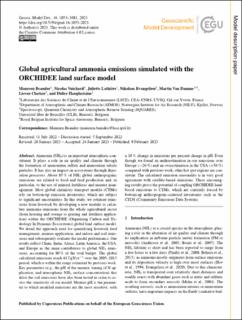| dc.description.abstract | Ammonia (NH3) is an important atmospheric constituent. It plays a role in air quality and climate through the formation of ammonium sulfate and ammonium nitrate particles. It has also an impact on ecosystems through deposition processes. About 85 % of NH3 global anthropogenic emissions are related to food and feed production and, in particular, to the use of mineral fertilizers and manure management. Most global chemistry transport models (CTMs) rely on bottom-up emission inventories, which are subject to significant uncertainties. In this study, we estimate emissions from livestock by developing a new module to calculate ammonia emissions from the whole agricultural sector (from housing and storage to grazing and fertilizer application) within the ORCHIDEE (Organising Carbon and Hydrology In Dynamic Ecosystems) global land surface model. We detail the approach used for quantifying livestock feed management, manure application, and indoor and soil emissions and subsequently evaluate the model performance. Our results reflect China, India, Africa, Latin America, the USA, and Europe as the main contributors to global NH3 emissions, accounting for 80 % of the total budget. The global calculated emissions reach 44 Tg N yr−1 over the 2005–2015 period, which is within the range estimated by previous work. Key parameters (e.g., the pH of the manure, timing of N application, and atmospheric NH3 surface concentration) that drive the soil emissions have also been tested in order to assess the sensitivity of our model. Manure pH is the parameter to which modeled emissions are the most sensitive, with a 10 % change in emissions per percent change in pH. Even though we found an underestimation in our emissions over Europe (−26 %) and an overestimation in the USA (+56 %) compared with previous work, other hot spot regions are consistent. The calculated emission seasonality is in very good agreement with satellite-based emissions. These encouraging results prove the potential of coupling ORCHIDEE land-based emissions to CTMs, which are currently forced by bottom-up anthropogenic-centered inventories such as the CEDS (Community Emissions Data System). | en_US |

